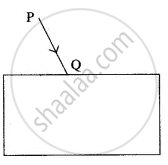Advertisements
Advertisements
Question
While tracing the path of a ray of light passing through a rectangular glass slab a student tabulated his observations as given below:
|
S.NO. |
∠i |
∠r |
∠e |
|
I |
60° |
40° |
61° |
|
II |
50° |
36° |
51° |
|
III |
40° |
28° |
39° |
|
IV |
30° |
20° |
31° |
The correct observations is:
(A) I
(B) II
(C) III
(D) IV
Solution
Using Snell’s law, sin i/sin r = n2/n1, check the ratio of the sine values of i and r which gives 1.5 (we know, n2=1.5 and n1=1) will be the answer.
The Correct Answer is D
RELATED QUESTIONS
Write a relationship between the angle of incidence and angle of refractions for a given pair of media
With the help of diagram of the principal section of a prism, indicate its refracting surfaces, refracting edge and base.
How does the angle of minimum deviation produces by a prism change with increase in :
the wavelength of incident light
A ray of light falls normally on the surface of a transparent glass slab. Draw a ray diagram to show its path and also mark angle of incidence and angle of emergence.
In an experiment of finding the refractive index of glass, if blue light is replaced by the red light, how will the refractive index of glass change? Give reason in support of your answer.
Name two instruments of the total refracting prism in which is used.
In the diagram below, PQ is a ray of light incident on a rectangular glass block.

How are the angles ‘i’ and ‘e’ related to each other?
Explain with the help of a diagram of how fish is able to see the objects above it.
The speed of light in air is 3 × 108 ms-1. Calculate the speed of light in water. The refractive index of water is 4/3.
The diagram below shows two parallel rays A (Orange) & B (Blue) incident from air, on air-glass boundary.

- Copy and complete the path of the rays A and B.
- How do the speeds of these rays differ in glass?
- Are the two refracted rays in glass parallel? Give a reason.
